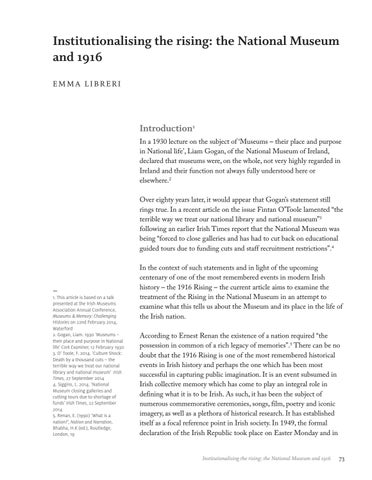Institutionalising the rising: the National Museum and 1916 EMMA LIBRERI
Introduction1 In a 1930 lecture on the subject of ‘Museums – their place and purpose in National life’, Liam Gogan, of the National Museum of Ireland, declared that museums were, on the whole, not very highly regarded in Ireland and their function not always fully understood here or elsewhere.2 Over eighty years later, it would appear that Gogan’s statement still rings true. In a recent article on the issue Fintan O’Toole lamented “the terrible way we treat our national library and national museum”3 following an earlier Irish Times report that the National Museum was being “forced to close galleries and has had to cut back on educational guided tours due to funding cuts and staff recruitment restrictions”.4
— 1. This article is based on a talk presented at the Irish Museums Association Annual Conference, Museums & Memory: Challenging Histories on 22nd February 2014, Waterford 2. Gogan, Liam. 1930 ‘Museums – their place and purpose in National life’ Cork Examiner, 12 February 1930 3. O’ Toole, F. 2014. ‘Culture Shock: Death by a thousand cuts – the terrible way we treat our national library and national museum’ Irish Times, 27 September 2014 4. Siggins, L. 2014. ‘National Museum closing galleries and cutting tours due to shortage of funds’ Irish Times, 22 September 2014 5. Renan, E. (1990) ‘What is a nation?’, Nation and Narration, Bhabha, H.K (ed.), Routledge, London, 19
In the context of such statements and in light of the upcoming centenary of one of the most remembered events in modern Irish history – the 1916 Rising – the current article aims to examine the treatment of the Rising in the National Museum in an attempt to examine what this tells us about the Museum and its place in the life of the Irish nation. According to Ernest Renan the existence of a nation required “the possession in common of a rich legacy of memories”.5 There can be no doubt that the 1916 Rising is one of the most remembered historical events in Irish history and perhaps the one which has been most successful in capturing public imagination. It is an event subsumed in Irish collective memory which has come to play an integral role in defining what it is to be Irish. As such, it has been the subject of numerous commemorative ceremonies, songs, film, poetry and iconic imagery, as well as a plethora of historical research. It has established itself as a focal reference point in Irish society. In 1949, the formal declaration of the Irish Republic took place on Easter Monday and in
Institutionalising the rising: the National Museum and 1916
73













